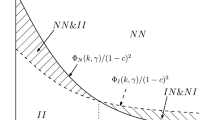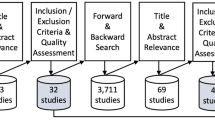Abstract
In a price competition between two original equipment manufacturers (OEMs), we investigate under which conditions each OEM chooses to outsource its production to a contract manufacturer (CM) under the assumption that outsourcing improves product quality but may come with a higher cost. A characterization of subgame perfect Nash equilibrium also reveals the two OEMs’ optimal pricing strategies in each case of insourcing versus outsourcing decisions. Later, in an extension of our model, we assume that there are two competing CMs that aim to attract outsourcing OEMs by setting a sufficiently low price level, and we further analyze how equilibrium sourcing and pricing strategies change compared to those in the main model.


Similar content being viewed by others
Notes
As apparent in the latter example, it is surely possible for an OEM to partially outsource its production, by producing certain components in house while outsourcing the production of the remaining components.
In a sense, CM is specialized in the production of the outsourceable component and able to supply a higher-quality product.
It is worth noting that the nature of outsourcing could be reversed in our model. That is, one can assume that outsourcing production is less costly for sure, as common in the textile industry, and then let CM optimally determine its product quality, which could turn out to be lower than OEM’s insourcing quality in equilibrium, so that there is still a cost versus quality trade-off in an outsourcing decision.
The reader is referred to Concluding Remarks for details and other real-life examples.
There are also studies on the effect of learning-by-doing (see Gray et al. 2009), the effect of two-part tariffs in outsourcing contracts (see Feng and Lu 2013), when a CM is a potential competitor for an OEM (see Wang et al. 2013), whether to outsource to a third-party supplier or to a competing OEM (see Pun 2015), and whether to outsource to an environmentally responsible supplier (see Guo et al. 2016).
The simultaneous nature of the second stage game is captured by the dashed line connecting Firm 2’s decision nodes in the figure.
For other model interpretations, \(C_I\) could be the additional unit cost of producing the outsourceable component in house.
It is worth noting that the case of full outsourcing where CM produces all components of the final product is captured in our model. If one simply assumes that \(C = 0\), this can be interpreted as if there is no manufacturing process handled by an outsourcing OEM.
It is worth reminding that these results are presented under the assumption that \(\overline{P_{t,1}} > \overline{P_{t,2}}\) (i.e., \(r > 1\)). If the converse inequality holds, then for sufficiently low values of r, implying a significant demand advantage for firm 2, it would be firm t’s optimal strategy to supply its technology only to firm 2.
The prices \(P_a\) and \(P_b\) and marginal costs \(C_a\) and \(C_b\) replace the notation \(P_t\) and \(C_t\) used in the previous section, respectively.
The implicit equilibrium characterization for the generalized version is available upon request.
An additional condition that needs to be satisfied is that their pricing strategies yield non-negative profits to the respective CMs. Yet, this condition is easily satisfied if T is sufficiently high.
As mentioned earlier, the common CM has a substantial market power in the main model, and this is one of the reasons why there can be an equilibrium where all benefit is collected by the CM. Our model extension can partially solve this issue, since the introduction of another supplier gives a considerable outside option to the two OEMs, which arguably makes the model more realistic.
References
Ang J, Fukushima M, Meng F, Noda T, Sun J (2013) Establishing Nash equilibrium of the manufacturer-supplier game in supply chain management. J Global Optim 56(4):1297–1312
Arruñada B, Vázquez XH (2006) When your contract manufacturer becomes your competitor. Harv Bus Rev 84(9):135–144
Arya A, Mittendorf B, Sappington DE (2008) Outsourcing, vertical integration, and price versus quantity competition. Int J Ind Organiz 26(1):1–16
Banker RD, Khosla I, Sinha KK (1998) Quality and competition. Manage Sci 44(9):1179–1192
Cachon GP, Harker PT (2002) Competition and outsourcing with scale economies. Manage Sci 48(10):1314–1333
Cachon GP, Lariviere MA (2005) Supply chain coordination with revenue-sharing contracts: strengths and limitations. Manage Sci 51(1):30–44
Chen Y, Chen G, Xu J, Duan H (2023) Sourcing diversification: Strategy selection, sourcing allocation and brand power. Comput Ind Eng 181:109307
Chen Y, Karamemis G, Zhang J (2021) A win-win strategy analysis for an original equipment manufacturer and a contract manufacturer in a competitive market. Eur J Oper Res 293(1):177–189
Cheng LC, Cantor DE, Dresner M, Grimm CM (2012) The impact of contract manufacturing on inventory performance: an examination of US manufacturing industries. Decis Sci 43(5):889–928
Cui Q (2019) Quality investment, and the contract manufacturer’s encroachment. Eur J Oper Res 279(2):407–418
Deng S, Guan X, Xu J (2021) The coopetition effect of learning-by-doing in outsourcing. Int J Prod Res 59(2):516–541
Deng S, Xu J (2023) Manufacturing and procurement outsourcing strategies of competing original equipment manufacturers. Eur J Oper Res 308(2):884–896
Dong Y, Xu K, Xu Y, Wan X (2016) Quality management in multi-level supply chains with outsourced manufacturing. Prod Oper Manag 25(2):290–305
Fan Z-P, Chen Z, Zhao X (2022) Battery outsourcing decision and product choice strategy of an electric vehicle manufacturer. Int Trans Oper Res 29(3):1943–1969
Feng Q, Lu LX (2012) The strategic perils of low cost outsourcing. Manage Sci 58(6):1196–1210
Feng Q, Lu LX (2013) The role of contract negotiation and industry structure in production outsourcing. Prod Oper Manag 22(5):1299–1319
Gilbert SM, Xia Y, Yu G (2006) Strategic outsourcing for competing OEMs that face cost reduction opportunities. IIE Trans 38(11):903–915
Gray JV, Tomlin B, Roth AV (2009) Outsourcing to a powerful contract manufacturer: the effect of learning-by-doing. Prod Oper Manag 18(5):487–505
Guo P, Song JS, Wang Y (2010) Outsourcing structures and information flow in a three-tier supply chain. Int J Prod Econ 128(1):175–187
Guo R, Lee HL, Swinney R (2016) Responsible sourcing in supply chains. Manage Sci 62(9):2722–2744
Heese HS, Kemahlıoğlu-Ziya E, Perdikaki O (2021) Outsourcing under competition and scale economies: when to choose a competitor as a supplier. Decis Sci 52(5):1209–1241
Jin Y, Hu Q, Kim SW, Zhou SX (2019) Supplier development and integration in competitive supply chains. Prod Oper Manag 28(5):1256–1271
Kaya M, Özer Ö (2009) Quality risk in outsourcing: noncontractible product quality and private quality cost information. Nav Res Logist 56(7):669–685
Kaya O (2011) Outsourcing versus in-house production: a comparison of supply chain contracts with effort dependent demand. Omega 39(2):168–178
Lai G, Liu Y, Xiao W (2021) International taxation and production outsourcing. Prod Oper Manag 30(2):402–418
Li W, Chen J, Chen B (2020) Sourcing strategy of original equipment manufacturer with quality competition. Decis Sci 51(5):1110–1130
Li W, Zhao X (2022) Competition or coopetition? Equilibrium analysis in the presence of process improvement. Eur J Oper Res 297(1):180–202
Li W, Zhao X, Chen J (2023) Co-opetition or decentralization? A study of manufacturers’ sourcing and distribution strategies. Eur J Oper Res 311(3):867–886
Li X, Li Y (2016) Chain-to-chain competition on product sustainability. J Clean Prod 112:2058–2065
Mahmoodi A (2020) Stackelberg-Nash equilibrium of pricing and inventory decisions in duopoly supply chains using a nested evolutionary algorithm. Appl Soft Comput 86:105922
Mandal P, Jain T (2021) Partial outsourcing from a rival: Quality decision under product differentiation and information asymmetry. Eur J Oper Res 292(3):886–908
Naghavi A, Ottaviano GI (2010) Outsourcing, complementary innovations, and growth. Ind Corp Chang 19(4):1009–1035
Nagurney A, Li D (2015) A supply chain network game theory model with product differentiation, outsourcing of production and distribution, and quality and price competition. Ann Oper Res 226(1):479–503
Plambeck EL, Taylor TA (2005) Sell the plant? The impact of contract manufacturing on innovation, capacity, and profitability. Manage Sci 51(1):133–150
Pun H (2015) The more the better? Optimal degree of supply-chain cooperation between competitors. J Oper Res Soc 66(12):2092–2101
Raweewan M, Ferrell WG Jr (2018) Information sharing in supply chain collaboration. Comput Ind Eng 126:269–281
Sim J, Kim B (2021) Sourcing decision in the presence of a complementary component. Omega 101:102281
Wang Y, Niu B, Guo P (2013) On the advantage of quantity leadership when outsourcing production to a competitive contract manufacturer. Prod Oper Manag 22(1):104–119
Wu D, Baron O, Berman O (2009) Bargaining in competing supply chains with uncertainty. Eur J Oper Res 197(2):548–556
Wu X, Zhang F, Zhou Y (2022) Brand spillover as a marketing strategy. Manage Sci 68(7):5348–5363
Xiao T, Xia Y, Zhang GP (2014) Strategic outsourcing decisions for manufacturers competing on product quality. IIE Trans 46(4):313–329
Xu H, Liu X, Huang H (2023) Information sharing and order allocation rule in dual-sourcing. Omega 114:102741
Yoo SH, Choi TY, Kim D (2021) Multitier incentive strategies for quality improvement: case of three-tier supply chain. Decis Sci 52(5):1137–1168
Zhang M, Zhang J, Sun Y, Cheng TCE (2022) How to outsource production considering quality management: Turnkey or buy-sell? Omega 113:102707
Zhu K, Zhang RQ, Tsung F (2007) Pushing quality improvement along supply chains. Manage Sci 53(3):421–436
Author information
Authors and Affiliations
Corresponding author
Ethics declarations
Conflict of interest
The author declares no conflict of interest.
Additional information
Publisher's Note
Springer Nature remains neutral with regard to jurisdictional claims in published maps and institutional affiliations.
I would like to thank the editor and two anonymous reviewers for helpful comments and suggestions. I also thank Shakiba Mikaeili Khiavi for her research assistance. The usual disclaimer applies.
Supplementary Information
Below is the link to the electronic supplementary material.
Rights and permissions
Springer Nature or its licensor (e.g. a society or other partner) holds exclusive rights to this article under a publishing agreement with the author(s) or other rightsholder(s); author self-archiving of the accepted manuscript version of this article is solely governed by the terms of such publishing agreement and applicable law.
About this article
Cite this article
Keskin, K. Sourcing strategies in a price and quality competition. Cent Eur J Oper Res (2024). https://doi.org/10.1007/s10100-024-00904-5
Accepted:
Published:
DOI: https://doi.org/10.1007/s10100-024-00904-5




